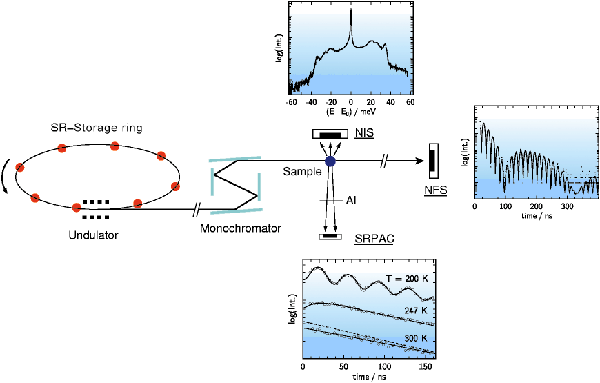- Home
- Users & Science
- Scientific Documentation
- ESRF Highlights
- ESRF Highlights 2002
- High Resolution and Resonance Scattering
- Synchrotron Radiation-based Perturbed Angular Correlation
Synchrotron Radiation-based Perturbed Angular Correlation
Research based on nuclear resonant scattering of synchrotron radiation (SR) has increased greatly in the last few years. The intense, spatially-coherent channel of Nuclear Forward Scattering (NFS) has been used to determine static and dynamic hyperfine interactions as well as slow and fast spatial dynamics of Mössbauer atoms in the solid state. The spatially-incoherent channel of Nuclear Inelastic Scattering (NIS) has been employed to measure the partial densities of phonons coupling to the Mössbauer atoms in soft and hard condensed matter. Both methods excel when applied to small samples under extreme conditions given e.g. by combinations of high pressure, low temperature, strong magnetic fields, etc. With increasing intensity of the beamlines a third method, SR-based Perturbed Angular Correlation (SRPAC), pioneered at ESRF six years ago [1], has now become accessible for applications in soft matter. The techniques described above are compared in Figure 75.
 |
|
Fig. 75: Nuclear resonant scattering of synchrotron radiation: Scattering geometries and typical measurements with NFS, NIS and SRPAC. |
SRPAC is basically a scattering variant of Time-Differential Perturbed Angular Correlation (TDPAC), a method well known in nuclear solid state physics (see e.g. [2]). In SRPAC the intermediate nuclear level is not excited from above via a cascade originating from the decay of a radioactive parent like in TDPAC, but from below, i.e. from the groundstate, during spatially incoherent, single-nucleus resonant scattering of SR. This scattering channel avoids, in contrast to TDPAC, any chemical or electronic after-effects. Directional selection and timing by the first detector in TDPAC are replaced in SRPAC by the direction and the timing of the incident SR flash. In both methods the interference of indistinguishable paths via an intermediate nuclear level split by magnetic dipole and/or electric quadrupole interaction allows one to investigate hyperfine interactions and rotational dynamics of the nuclear probes.
The lower panel in Figure 75 shows an example, where SRPAC has recently been applied at beamline ID18 to study the rotational dynamics of the molecular glass former 5%ferrocene/dibutylphthalate above the glass transition. At 200 K the time evolution is characterised by a natural decay with lifetime of ~ 141 ns, modulated by a pronounced quantum beat which corresponds to the quadrupole splitting of ferrocene. The beat exhibits only a weak damping, indicating still very slow relaxation. At 247 K the beat is largely overdamped due to medium relaxation. At 300 K the slow approach of the natural decay (dotted line) is characteristic of fast relaxation (Abragam-Pound limit).
The potential of SRPAC relies on the fact that single-nucleus scattering depends neither on recoil-free emission and absorption, nor on translational motion. Therefore, SRPAC allows one to continue Mössbauer investigations of hyperfine interactions and rotational dynamics into regions where the Lamb-Mössbauer factor vanishes, i.e. in soft matter and viscous liquids. It is expected that SRPAC using the 57Fe-resonance can cover a dynamic range of relaxation times of five orders of magnitude, from ~ 10 ps up to 1 µs. Furthermore, SRPAC enables one to investigate pure rotational dynamics in hard-condensed matter as well. In combination with Mössbauer spectroscopy or NFS, translational and rotational dynamics can be separated.
References
[1] A.Q.R. Baron et al., Europhys. Lett. 34, 331 (1996).
[2] T. Butz, Z. Naturforsch. 41a, 396 (1996).
Principal Publication and Authors
I. Sergueev (a,b), U. van Bürck (a), A.I. Chumakov (b,c), T. Asthalter (d), G.V. Smirnov (c), H. Franz (e), R. Rüffer (b), W. Petry (a), to be submitted to Phys. Rev. Lett.
(a) TUM Physik E13, Garching (Germany)
(b) ESRF
(c) RRC, Moscow (Russia)
(d) Univ. Stuttgart, Physikal. Chemie (Germany)
(e) DESY, HASYLAB, Hamburg (Germany)



